- Submissions

Full Text
Examines in Marine Biology & Oceanography
Flowering Events of Posidonia oceanica Meadows along the Western Mediterranean Coasts of Italy
Nicola Cantasano*
Retired Researcher, National Research Council, Institute for Agricultural and Forest Systems in the Mediterranean, Rende Research Unit, Italy
*Corresponding author: Nicola Cantasano, Retired Researcher, National Research Council, Institute for Agricultural and Forest Systems in the Mediterranean, Rende Research Unit, Rende, Cs., Italy
Submission: September 11, 2025;Published: October 29, 2025

ISSN 2578-031X Volume7 Issue 5
Abstract
Posidonia oceanica (L.) Delile, endemic species of the Mediterranean sea, forms extensive meadows in the infralittoral coastal seawaters of the basin. Actually, Posidonia beds are suffering a fast regression caused by marine pollution and by an increasing human pressure. However, in these last decades the warming trend of Mediterranean coastal waters have caused an increase of Posidonia flowering events, as a consequence of a sexual reproduction of the species, especially along the Western Mediterranean coasts of Italy. This study shows all the flowering events occurred along Italian coasts in last decades, reporting a lot of records in the Western Mediterranean basin. The research highlights a clear link between the increasing trend of flowering events and the gradual rise of Sea Surface Temperature occurring in the Western Mediterranean seawaters. A case study reporting a massive flowering event in the Calabria Tyrrhenian coast, occurred in the year 2025, confirms this increasing trend and the shift of reproductive modes of the species towards sexual reproduction. So, Posidonia oceanica could represent an early signal of a climate change scenario.
Keywords:Posidonia flowerings; Sea olives; Seedlings; Sea surface temperatures; Italian coasts
Introduction
The marine phanerogam Posidonia oceanica (L.) Delile is one of the most important endemic species living in the infralittoral bottoms of the basin [1] where it can forms, in good and pristine conditions, the typical “climax” ecosystem [2] on rocks and sandy bottoms from the surface to over 40 meters depth, according to light conditions [3,4]. In time, Posidonia beds, covering a global surface area of 2.5 million hectares [5], have become priority habitat within the Habitat Directive (92/43/EC) and inserted as “Best Concern Ecosystem” as stated by the Red List of International Union for Conservation of Nature (IUCN) [6]. However, in recent decades Posidonia meadows are undergoing rapid regression mainly due to marine pollution caused by an increasing human pressure. To date, scientific data, updated to 2015, have confirmed this negative trend reporting a total extension of the Mediterranean meadows such as 1.2 million hectares [7] with a reduction rate of about 50% in a time lag of only fifteen years. These conditions have been strengthened by the poor genetic variability of the species whose primary mechanism of reproduction is vegetative through a kind of clonal growth from perennial rhizomes while flowering and fruiting, by sexual reproduction, have been always considered rare and uncommon [8,9]. Nevertheless, the gradual warming of Mediterranean seawaters, together with the increasing number of field studies have given a sharp increase of Posidonia flowerings in the Mediterranean Sea, especially along Italian coasts [10-50]. Posidonia oceanica shows in these last decades a gradual shift towards modes of sexual reproduction giving to the species a greater genetic diversity and a better response against environmental changes [51].
Materials and Methods
The study has been realized through a detailed research of peer-reviewed scientific literature searched by the most important electronic databases such as Web of Science, Science Direct, Scopus and Research Gate. In this way, it was possible to select the most important papers regarding the following keywords: Posidonia flowerings, Posidonia seedlings, sea olives, Sea Surface Temperatures, Western Mediterranean Sea, Italian coasts. The bibliographic research has been conducted until 31 december 2024, regarding all the most relevant and available scientific literature. From the comprehensive data set, it has been removed articles unrelated to the searched keywords, grey literature and duplicate articles. From this choice, a total of 120 articles has been selected. Afterwards, 61 records were excluded for publication titles and subject areas. Finally, according to a deep analysis of their contents, 59 articles have been selected, cited in the main text and reported in the list of references.
Results and Discussions
This study gives some information about the occurrence of flowering events of Posidonia meadows in the period 1973-2023 along Italian coastal waters in the Western Mediterranean basin, as shown in the following table (Table 1). The yearly data reported by scientific literature in Table 1 show 173 records along the Italian coasts of the western Mediterranean basin. The flowering events are characterized by a weak but steady increasing trend (R2=0.0003) from 1973 to 2023 years, as highlighted by the dotted line of figure 1, where the continuous line suggests a sort of cyclicity of flowering records with peaks occurring regularly every 10-12 years (Figure 1).
Table 1:Flowering reports recorded in the Western Mediterranean basin of Italian seawaters drawn by scientific literature (legend: N=Number of records).
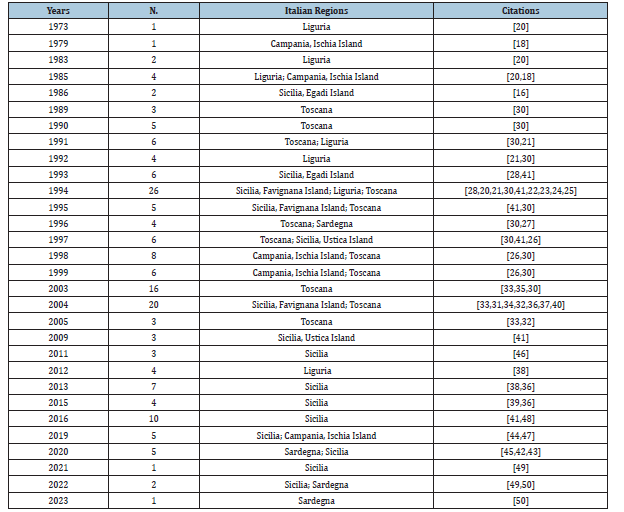
Figure 1:The increasing trend of flowering events, reported from 1973 to 2023 years, in the coastal seawaters of Italian coasts.
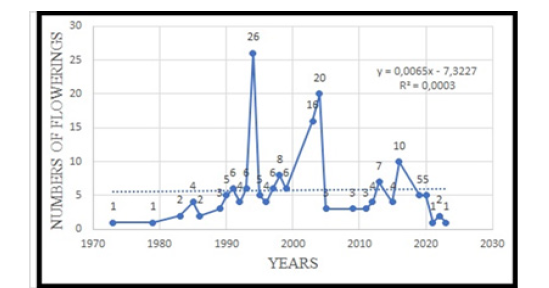
Amongst the main factors affecting the reproductive trait of Posidonia oceanica it could be hypothesized the light and gradual increase of Sea Surface Temperature (hereafter, SST) in the western Mediterranean seawaters. The trend of the course, characterized by some regular and spaced peaks, could be induced by conditions of thermal stress because such massive flowering events are closely related to corresponding peaks in seawater temperatures [10,12, 31,52]. Therefore, it could be suggested a close relationship between the flowerings of Posidonia meadows and the warming trend of Mediterranean seawaters. As a matter of fact, the species is characterized by an effective acclimatization capacity through its high thermotolerance against the increasing overheating of Mediterranean waters [53,54]. This warming trend was reported for the last decades as 0.04 °Cyr-1 [31] while the thermal increase of SST medium values in the Western Mediterranean seawaters, for the period 1959-2022, was released by NOAA data (USA National Oceanic and Atmospheric Administration) as +1.2 °C [55] (Figure 2). The continuous line in bold characters (Figure 2) shows the increasing trend, in the long run, valued through polynomial regression (from: www.snpambiente.it, accessed on 15 July 2025).
Figure 2:Increasing trend of SST in the Western Mediterranean seawaters from 1960 to 2022 years.
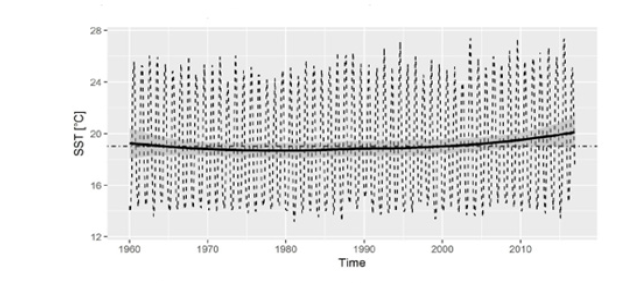
In this way, the Atmospheric Ocean Regional Climate (AORCM) predicted a global increase of Mediterranean SST of 2.6 °C in the period 2070-2099 [56]. Finally, the regional distribution of flowerings, for a whole national number of 173 reports, showed a great variability between the different Italian coastal regions of the Western Mediterranean sea with Sicilia, as the first country (73 records=42%), Toscana as second (62 records=35%), Liguria as third (20 records=12%), Campania as fourth (12 records=7%) and Sardegna as fifth (6 records=4%) (Figure 3). The high number of flowering records, recorded around Sicilia, was reported by scientific literature because the recruitment sites of seedlings was very often located in the shallow seawaters of Marine Protected Areas (MPAs) along the insulated coasts of Mediterranean Sea as Sicily, Egadi, Favignana and Ustica islands,
Figure 3:The regional distribution of flowerings in Italian coastal regions from 1973 to 2023 years..

case study: flowering events in Calabria Tyrrhenian coasts recorded on 2025 year
During a survey conducted to update the presence of the invasive algal species Caulerpa cylindracea Sonder, 1845 in the Western Mediterranean basin of Calabria coasts (Figure 4) it was observed on 15 May 2025 a massive event of flowering by Posidonia oceanica meadow whose fruits, named “sea olives”, was washed up on a sandy beach of S. Litterata Point (Cosenza, Calabria, Southern Italy). The Posidonia fruits found stranded in the study area mostly derive from an extensive meadow growing nearby in the shallow seawaters of S. Litterata. It was measured a high density of the beach-cast fruits from 10 to 30 units in quadrats 40cmx40 cm, while the main fruit density values varied from 15 to 40 fruits per m2, resulting from a big production of fruits ended up and stranded in great quantities on a sandy beach (Figure 5). Then, the fruits were collected and transported in the laboratory of the Center of Marine Environmental Education (C.E.A.M.) of Belmonte Calabro (Cs., Italy), managed by the World Wildlife Fund (W.W.F.) of Italy, to better understand the main patterns of this important beach-coast event. The fruits were embedded in spongy and ovoid pericarps and one of the fruits opened longitudinally releasing its single seed (Figure 6). The findings of this last occurence happened on 2025 year seem to confirm the assumption that sexual reproduction is becoming more widespread along italian coastal regions and this present trend is actually ongoing, coupled with the warming trend of the Western Mediterranean sea.
Figure 4:Geographic map of the study area along Calabria Tyrrhenian coast.
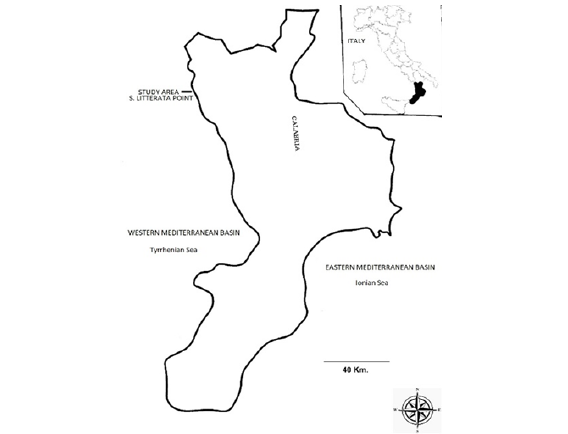
Figure 5:Beach-cast fruits of Posidonia oceanica stranded on the sandy beach of S. Litterata.
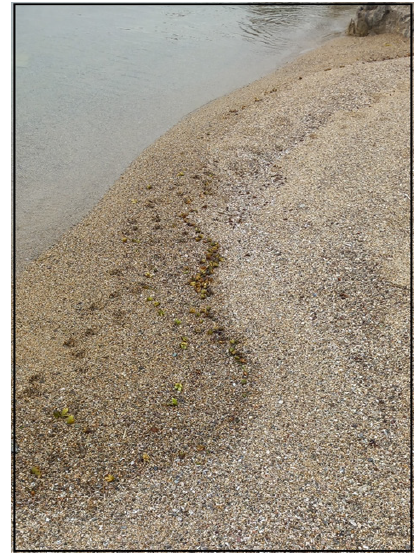
Figure 6:The fruits of Posidonia oceanica collected from the sandy beach of S. Litterata and a single seed released by its pericarp.

Conclusion
From the resulting data it is shown that the growing trend of SST in Mediterranean seawaters is supporting the sexual reproduction of Posidonia oceanica plants [57], as highlighted, also, by the increasing flowering events occurred from 1973 to 2023 years. In this way, the gradual shift of reproductive modes could favour a greater genetic diversity in the gene pool of the species, leading to a better thermotolerance to the warming trend of Mediterranean seawaters, particularly marked in the western basin. Besides, some experiments of restoration from beach-cast fruits, conducted on dead matte and on rocky substrata covered by seaweeds, seem to be a feasible tool for the recovery of Posidonia oceanica meadows in calm coastal environments with moderate depths [58,59]. Anyway, there are a lot of gaps in flowering dynamics and it is suggested to better understand the great variability of Posidonia flowerings in the western Mediterranean basin. In conclusions, Posidonia oceanica meadows could represent an early environmental signal in the climate change scenario induced by the warming trend of Mediterranean seawaters.
References
- Den Hartog C (1970) The seagrasses of the world. North Holland Publishing Company, Netherlands, pp. 1-275.
- Ghirardelli E (1981) Life in the waters. Italy, pp. 1-402.
- Hemminga M, Duarte CM (2000) Seagrass ecology. Cambridge University Press, UK, pp. 1-93.
- Procaccini G, Buia M, Gambi M, Perez M, Pergent G, et al. (2003) The seagrasses of the Western Mediterranean. World Atlas of Seagrasses. University of California Press, USA, pp. 48-58.
- Pasqualini V, Pergent-Martini C, Clabaut P, Pergent G (1998) Mapping of Posidonia oceanica using aerial photographs and side scan sonar. Application off the island of Corsica (France). Estuarine Coastal and Shelf Science 47(3): 359-367.
- Pergent G, Pergent-Martini C, Bein A, Dedeken M, Oberti P, et al. (2015) Dynamic of Posidonia oceanica seagrass meadows in the Northwestern Mediterranean: Could climate change to be blame? Comptes Rendus Biologies 338(7): 484-493.
- Telesca L, Belluscio A, Criscoli A, Ardizzone G, Apostolaki ET, et al. (2015) Seagrass meadows (Posidonia oceanica) distribution and trajectories of change. Scientific Reports 5: 12505.
- Molinier R, Picard J (1952) Research on marine phanerogam meadows on the French Mediterranean coast. Annals of the Institute Oceanographic 9(2): 157-234.
- Boudouresque CF, Giraud G, Perret, M (1977) Posidonia oceanica. CNEXO ET Organisation, Aix-Marseille University, pp. 1-191.
- Giraud G (1977) Census of fertile material of Posidonia oceanica (L.) Delile in the Mediterranean Sea. Reports and Minutes of Meetings - International Commission for the Scientific Exploration of the Mediterranean Sea (CIESM) 24(4): 126-130.
- Mazzella L, Gambi MC, Russo GF, Witmann J (1983) Flowering in Posidonia oceanica (L.) Delile prairies around the island of Ischia (Gulf of Naples). Reports and Minutes of the Meetings of the International Commission for the Scientific Exploration of the Mediterranean Sea 28(3): 117-119.
- Mazzella L, Gambi MC, Russo GF, Buia MC (1984) Deep flowering and fruiting of Posidonia oceanica beds around the island of Ischia (Gulf of Naples). In: Boudouresque CF, Grissac JA, Olivier J (Eds.), International Workshop on Posidonia oceanica Gis Posidonie publications, France, 1: 203-209.
- Cave G, Meinesz A (1984) Observations on the flowering and fruiting of Posidonia oceanica in the bay of Villefranche and in Southern Corsica. In: Jeudy GA, Olivier J (Eds.), International Workshop on Posidonia oceanica Boudouresque Gis Posidonie publications 1: 193-201 (In French).
- Pergent G (1985) Flowering of herbs in Posidonia oceanica in the Izmir region (Turkey). Posidonia Newsletter 1(1): 15-221.
- Boudouresque CF, Thelin C (1985) Flowering and fruiting of Posidonia oceanica: A standardized study protocol. CIESM Meeting Reports and Minutes. Monaco 29(5): 177-179.
- Buia MC, Peirano S (1989) Record of a Posidonia oceanica (L.) Delile seedling in the Egadi Island (Sicily, Italy). Posidonia newsletter 2: 19-22.
- Pergent G, Ben Maiz N, Boudouresque CN, Meinesz A (1989) The flowering of Posidonia oceanica over the last fifty years: A lepidoccronological study. In: Boudouresque CF, Grissac AJ, Olivier J (Eds.), International Workshop on Posidonia oceanica Gis Posidonie publications, France 2: 69-76.
- Buia MC, Mazzella L (1991) Reproductive phenology of the mediterranean seagrasses Posidonia oceanica (L.) Delile, Cymodocea nodosa (Urria) Ascherson and Zoostera noltii Aquatic Botany 40(4): 334-362.
- Semroud R (1993) Data on the ancient flowering of Posidonia oceanica (Linnaeus) Delile in the region of Algiers (Algeria). Posidonia newsletter 4(2): 31-35.
- Bussotti S, Guidetti P (1996) Lepidochronological study of Posidonia oceanica (L.) Delile blooms in Noli (Spotorno Bay, Ligurian Sea). Proceedings of the Italian Society of Ecology. 17: 305-308.
- Stoppelli N, Peirano A (1995) Continous flowering of Posidonia oceanica (L.) Delile in the bay of Monterosso a mare (SP) North Western Mediterranean Sea. Bulletin Museum Institute Biology 60-61: 31-40.
- Gambi MC, Buia MC, Mazzella L (1996) Record of a diffuse germination of Posidonia oceanica (L.) Delile in the Centrai Adriatic Sea (Croatia). Biologia Marina Mediterranea 3(1): 467-470.
- Gambi MC, Guidetti P (1998) Morphological observations on seedlings of Posidonia oceanica (L.) Delile germinated “in situ”. Biologia Marina Mediterranea 5(1): 549-552.
- Balestri E, Piazzi L, Cinelli F (1998) Survival and growth of transplanted and natural seedlings of Posidonia oceanica (L.) Delile in a damaged coastal area. Journal of Experimental Marine Biology and Ecology 228(2): 209-225.
- Piazzi L, Acunto S, Cinelli F (1999) In situ survival and development of Posidonia oceanica (L.) Delile seedlings. Aquatic Botany 63(2): 103-112.
- Buia MC, Gambi MC, Badalamenti F (2002) Morpho-chronological observations on seedlings and juvenile shoots of Posidonia oceanica (L.) Delile collected in situ in various coastal areas. Biologia Marina Mediterranea 9(1): 600-604.
- Guidetti P, Bussotti S (2002) Morpho-chronological observation on juvenile shoots of the seagrass Posidonia Oceanica. pp. 1-17.
- Balestri E, Cinelli F (2003) Sexual reproduction success in Posidonia oceanica. Aquatic Botany 75(1): 21-32.
- Balestri E, Vallerini F, Lardicci C (2002) A qualitative and quantitative assessment of the reproductive litter from Posidonia oceanica accumulated on a sand beach following a storm. Estuarine, Coastal and Shelf Science 66(1-2): 30-34.
- Diaz-Almela E, Marbà N, Álvarez E, Balestri E, Ruiz-Fernandez JM, et al. (2006) Patterns of seagrass (Posidonia oceanica) flowering in the Western Mediterranean. Marine Biology 148: 723-742.
- Diaz-Almela E, Marba N, Alvarez E, Santiago R, Martínez R, et al. (2008) Patch dynamics of the Mediterranean seagrass Posidonia oceanica: Implications for recolonisation process. Aquatic Botany 89(4): 397-403.
- Balestri E, Lardicci C (2008) First evidence of a massive recruitment of Posidonia oceanica spatial variation in first-year seedling abundance on heterogeneous substrate. Estuarine Coastal and Shelf Science 76(3): 634-641.
- Balestri E, Gobert S, Lepoint G, Lardicci C (2009) Seed nutrient content and nutritional status of Posidonia oceanica seedlings in the Northwestern Mediterranean Sea. Marine Ecology Progress Series 388: 99-109.
- Diaz-Almela E, Marba N, Martínez R, Santiago R, Duarte C (2009) Seasonal dynamics of Posidonia oceanica in Magalluf Bay (Mallorca, Spain): Temperature effects on seagrass mortality. Limnology and Oceanography 54(6): 2170-2182.
- Balestri E, Vallerini F, Lardicci C (2010) Effect of seed density and sediment nutrient heterogeneity on recruitment and early patch growth in the seagrass Cymodocea nodosa. Marine Ecology Progress Series 417: 63-72.
- Alagna A, Vega FT, Terlizzi A, Badalamenti F (2013) Influence of microhabitat on seedling survival and growth of the Mediterranean seagrass Posidonia oceanica (L.) Estuarine, Coastal and Shelf Science 119: 119-125.
- Bedini R, Nannelli A, Battistini F (2013) Restoration of Posidonia oceanica (L.) Delile meadows: Is there an effective methodology? Journal of Life Science 7(7): 722-726.
- Montefalcone M, Giovannetti E, Morri C, Peirano A, Bianchi CN (2013) Flowering of the seagrass Posidonia oceanica in the NW Mediterranean: Is there a link with solar activity? Mediterranean Marine Science 14(2): 416-423.
- Balestri E, Battisti D, Vallerini F, Lardicci C (2015) First evidence of root morphological and architectural variations in young Posidonia oceanica plants colonizing different substrate typologies. Estuarine, Coastal and Shelf Science 154: 205-213.
- Badalamenti F, Alagna A, Fici S (2015) Evidences of adaptive traits to rocky substrates undermine paradigm of habitat preference of the Mediterranean seagrass Posidonia oceanica. Scientific Reports 5(1): 8804.
- Balestri E, Vallerini F, Lardicci C (2017) Recruitment and patch establishment by seeds in the seagrass Posidonia oceanica: Importance and conservation implications. Frontiers in Plant Science 8: 1067.
- Alagna A, Zenone A, Badalamenti F (2020) The perfect microsite: How to maximize Posidonia oceanica seedling settlement success for restoration purposes using ecological knowledge. Marine Environmental Research 161: 104846.
- Zenone A, Alagna A, D'Anna G, Kovalev A, Kreitschitz A, et al. (2020) Biological adhesion in seagrasses: The role of substrate roughness in Posidonia oceanica (L.) Delile seedling anchorage via adhesive root hairs. Marine Environmental Research 160: 105012.
- Balestri E, Menicagli V, Lardicci C (2021) Managing biotic interactions during early seagrass life stages to improve seed‐based restoration. Journal of Applied Ecology 58(11): 2453-2462.
- Stipcich P, Pansini A, Beca-Carretero P, Dagmar-Stengel B, Ceccherelli G (2022) Field thermo acclimation increases the resilience of Posidonia oceanica seedlings to marine heat waves. Marine Pollution Bulletin 184: 114230.
- Tomasello A, Cassetti FP, Savona A, Pampalone V, Pirrotta M, et al. (2020) The use of very high-resolution images for studying Posidonia oceanica Vie et Milieu, Life and Environment 70(3-4): 25-35.
- Pazzaglia J, Nguyen HM, Santillán-Sarmiento A, Ruocco M, Dattolo E, et al. (2021) The genetic component of seagrass restoration: What we know and the way forwards. Water 13(6): 1-24.
- Zenone A, Badalamenti F, Alagna A, Gorb SN, Infantes E (2022) Assessing tolerance to the hydrodynamic exposure of Posidonia oceanica seedlings anchored to rocky sustrates. Frontiers in Marine Science 8: 788448.
- Rinaldi A, Martinez M, Badalamenti F, D’Anna G, Mirto S, et al. (2023) The ontogeny-specific thermal sensitivity of the seagrass Posidonia oceanica. Frontiers in Marine Science 10: 1183728.
- Stipcich P, Pansini A, Ceccherelli G (2024) Resistance of Posidonia oceanica seedlings to warming: Investigating the importance of the lag-phase duration between two heat events to thermo-priming. Marine Pollution Bulletin 204: 116515.
- Martinez-Abrain A, Castejòn-Silvo I, Roiloa S (2022) Foreesing the future of Posidonia oceanica meadows by accounting for the past evolution of the Mediterranean Sea. ICES Journal of Marine Science 79(10): 2597-2599.
- Boyer M, Bussotti S, Guidetti P, Matricardi G (1996) Notes on the flowering and fruiting of Posidonia oceanica (L.) Delile beds in the Ligurian Sea (North-Western Mediterranean). Bulletin of the Museums and Biological Institutes of the University of Genoa 60-61: 21-29.
- Marin-Guirao L, Ruiz JM, Dattolo E, Garcia-Muñoz R, Procaccini G (2016) Physiological and molecular evidence of differential short-term heat tolerance in Mediterranean seagrasses. Scientific Reports 6: 28615.
- Marín-Guirao L, Bernardeau-Esteller R, García-Muñoz A, Ramos Y, Ontoria J, et al. (2018) Carbon economy of Mediterranean seagrasses in response to thermal stress. Marine Pollution Bulletin 135: 617-629.
- National System for Environmental Protection (2019) SNPA Environment Report 2018 Edition, Italy.
- Somot S, Sezault F, Déqué M, Crépon M (2008) 21st century climate change scenario for the Mediterranean using a coupled atmosphere-ocean regional climate model. Global Planet Change 63(2-3): 112-126.
- Marin-Guirao L, Entrambasaguas L, Ruiz JM, Procaccini G (2019) Heat-stress induced flowering can be a potential adaptive response to ocean warming for the iconic seagrass Posidonia oceanica. Molecular Ecology 28(10): 2486-2501.
- Terrados J, Marin A, Cedràn D (2013) Use of Posidonia oceanica seedlings from beach-cast fruits for seagrass planting. Botanica Marina 56(2): 185-195
- Escandel-Weststcott E, Riera R, Hernandez-Muñoz N (2023) Posidonia oceanica restoration review: Factors affecting seedlings. Journal of Sea Research 191: 102337.
© 2025 Nicola Cantasano*. This is an open access article distributed under the terms of the Creative Commons Attribution License , which permits unrestricted use, distribution, and build upon your work non-commercially.
 a Creative Commons Attribution 4.0 International License. Based on a work at www.crimsonpublishers.com.
Best viewed in
a Creative Commons Attribution 4.0 International License. Based on a work at www.crimsonpublishers.com.
Best viewed in 







.jpg)






























 Editorial Board Registrations
Editorial Board Registrations Submit your Article
Submit your Article Refer a Friend
Refer a Friend Advertise With Us
Advertise With Us
.jpg)






.jpg)














.bmp)
.jpg)
.png)
.jpg)










.jpg)






.png)

.png)



.png)






